Differences from wild rats
While domesticated rats are not removed enough from their wild
counterparts to justify a distinct species (like the dog versus grey
wolf), there are significant differences that set them apart;
the most apparent is coloring.
Random color mutations may occur in the wild, but these are rare. Most
wild R. norvegicus are a dark brown color, while fancy rats may be
anything from white to cinnamon to blue.

Behaviorally, domesticated pet rats are tamer than those in the wild.
They are more comfortable around humans and known to seek out their
owners while roaming freely.
They have decreased reactions to light and sound, are less cautious of
new food, and have better tolerance to overcrowding.
Domesticated rats are shown to mate earlier, more readily, and for a
longer period of time over their lifespan.
Also, domesticated rats exhibit different behaviors when fighting with
each other:
while wild rats almost always flee a lost battle, caged rats spend
protracted amounts of time in a belly-up or boxing position.
These
behavioral traits are thought to be products of environment as opposed
to genetics.

However, it is also theorized that there are certain underlying
biological reasons for why some members of a wild species are more
receptive to domestication than others, and that these differences are
then passed down to offspring (compare domesticated silver fox).
The body structure of domesticated rats differs from that of a wild rat
as well.
The body of a fancy rat is smaller, with larger ears and a longer tail.
Domesticated rats have generally smaller and sharper facial features as
well.

Domesticated rats have a longer lifespan than that of wild rats.
Because domesticated rats are protected from predators and have ready
access to food, water, shelter, and medical care, their average lifespan
is around two to three years, in contrast to wild Rats.
norvegicus, which average a lifespan of less than one year.
However, wild rats generally have larger brains, hearts, livers,
kidneys, and adrenal glands than laboratory rats.
The fancy rat and wild rat also each face a multitude of differing
health concerns;
the former is at risk of developing a pneumococcal infection from
exposure to humans, while the latter may harbor tapeworms after coming
in contact with carriers such as cockroaches and fleas.